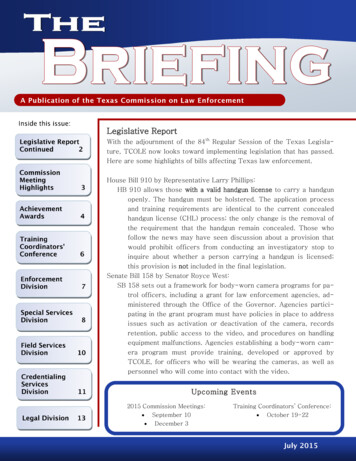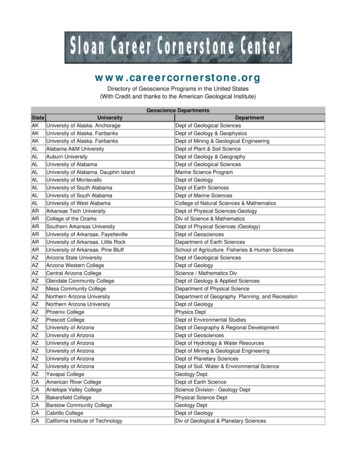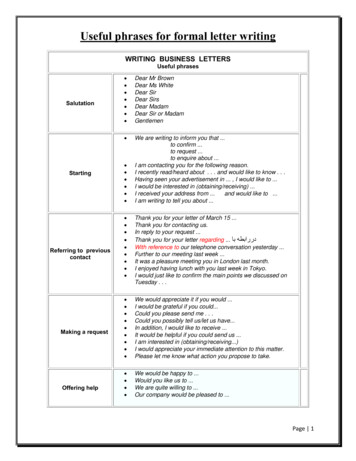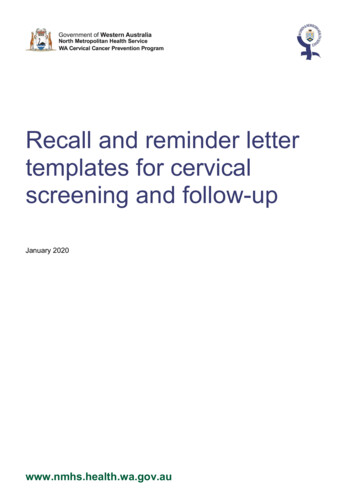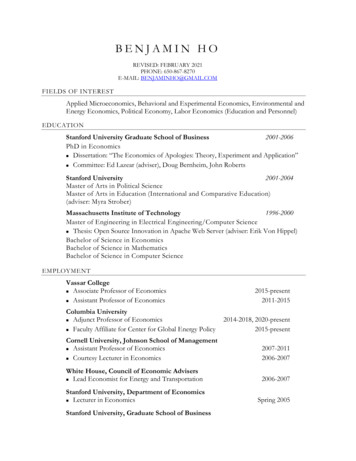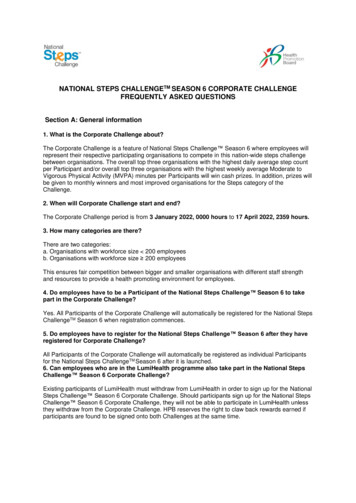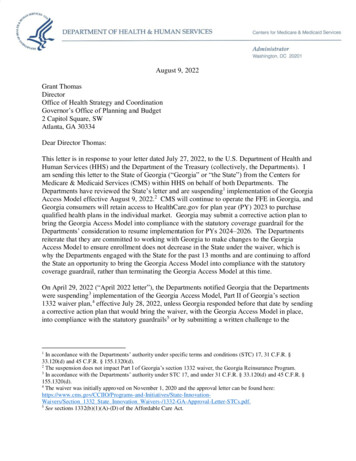
Transcription
Page 1August 9, 2022Grant ThomasDirectorOffice of Health Strategy and CoordinationGovernor’s Office of Planning and Budget2 Capitol Square, SWAtlanta, GA 30334Dear Director Thomas:This letter is in response to your letter dated July 27, 2022, to the U.S. Department of Health andHuman Services (HHS) and the Department of the Treasury (collectively, the Departments). Iam sending this letter to the State of Georgia (“Georgia” or “the State”) from the Centers forMedicare & Medicaid Services (CMS) within HHS on behalf of both Departments. TheDepartments have reviewed the State’s letter and are suspending1 implementation of the GeorgiaAccess Model effective August 9, 2022.2 CMS will continue to operate the FFE in Georgia, andGeorgia consumers will retain access to HealthCare.gov for plan year (PY) 2023 to purchasequalified health plans in the individual market. Georgia may submit a corrective action plan tobring the Georgia Access Model into compliance with the statutory coverage guardrail for theDepartments’ consideration to resume implementation for PYs 2024–2026. The Departmentsreiterate that they are committed to working with Georgia to make changes to the GeorgiaAccess Model to ensure enrollment does not decrease in the State under the waiver, which iswhy the Departments engaged with the State for the past 13 months and are continuing to affordthe State an opportunity to bring the Georgia Access Model into compliance with the statutorycoverage guardrail, rather than terminating the Georgia Access Model at this time.On April 29, 2022 (“April 2022 letter”), the Departments notified Georgia that the Departmentswere suspending 3 implementation of the Georgia Access Model, Part II of Georgia’s section1332 waiver plan, 4 effective July 28, 2022, unless Georgia responded before that date by sendinga corrective action plan that would bring the waiver, with the Georgia Access Model in place,into compliance with the statutory guardrails 5 or by submitting a written challenge to theIn accordance with the Departments’ authority under specific terms and conditions (STC) 17, 31 C.F.R. §33.120(d) and 45 C.F.R. § 155.1320(d).2The suspension does not impact Part I of Georgia’s section 1332 waiver, the Georgia Reinsurance Program.3In accordance with the Departments’ authority under STC 17, and under 31 C.F.R. § 33.120(d) and 45 C.F.R. §155.1320(d).4The waiver was initially approved on November 1, 2020 and the approval letter can be found tives/State-InnovationWaivers/Section 1332 State Innovation Waivers-/1332-GA-Approval-Letter-STCs.pdf.5See sections 1332(b)(1)(A)-(D) of the Affordable Care Act.1
Page 2Departments’ determinations.6,7 In the April 2022 letter, the Departments outlined theinformation Georgia needed to provide within 90 days as part of any corrective action plan todemonstrate how the State would improve the Georgia Access Model to meet the statutorycoverage guardrail and ensure the waiver would not result in coverage losses in the State.Further, the Departments explained that they expected that any corrective action plan from theState would include a revised outreach and communications plan, including planned funding, aspend plan, and additional information on engagement with underserved communities, to ensureadditional outreach actions under the Georgia Access Model are sufficient to replace projectedfederal outreach spending and to avert projected coverage losses due to the transition to theGeorgia Access Model, net of any coverage increases attributable to reinsurance. In addition, theDepartments noted that the State should, as part of its efforts to avert projected coverage losses,comply with and pass readiness reviews, as specified in the specific terms and conditions (STCs)governing Georgia’s section 1332 waiver.On July 27, 2022, Georgia submitted a written challenge to the Departments’ determinations.The State’s letter challenges the Departments’ basis for suspending the Georgia Access Modeland contends that the Georgia Access Model does comply with the statutory coverage guardrail.The State did not submit a corrective action plan or provide other information to demonstrate itwould ensure additional outreach under the Georgia Access Model is sufficient to avert theprojected coverage losses, net of any coverage increases attributable to reinsurance. In addition,there continues to be a lack of adequate information about engagement with underservedpopulations and community organizations, as well as deficiencies with Georgia’s implementationefforts and demonstration of the Model’s readiness to go live for PY 2023.The Departments’ Decision to Suspend the Georgia Access ModelThe Departments have reviewed the State’s written challenge. While Georgia had 90 days fromreceipt of the Departments’ April 2022 letter to address the concerns raised, the State did notsubmit a corrective action plan to demonstrate how the State would improve the Georgia AccessModel to meet the statutory coverage guardrail and ensure the waiver would not result insubstantial projected coverage losses in the State, nor did its written challenge provide analysisdemonstrating that the waiver would comply with the coverage guardrail absent correctiveaction. Further, after review of the State’s written challenge, the Departments are upholdingtheir determinations that: (1) the State materially failed to comply with the STCs by repeatedlyrefusing to provide the Departments with the information requested as part of the Departments’monitoring and oversight authority; 8 and (2) the State has not demonstrated that the Georgiawaiver, with the Georgia Access Model in place and absent corrective action, meets the statutorycoverage guardrail in light of changes in federal law, policy, and other circumstances thatmaterially affect the without-waiver baseline scenario. In addition to these findings, theDepartments have also determined, based on readiness reviews conducted to date, that Georgiahas not satisfied certain operational readiness requirements for a novel state program such as theGeorgia Access Model. Nor has the State provided an adequate outreach and communicationsThe suspension does not impact Part I of Georgia’s section 1332 waiver, the Georgia Reinsurance Program.A copy of the Departments’ April 29, 2022, letter is available at: ion-Letter-GA-Access-Model.pdf.8In accordance with the Departments’ authority under STC 15, 31 C.F.R. § 33.120(f), and 45 C.F.R. § 155.1320(f).67
Page 3plan. These operational and planning deficiencies are an additional basis for suspendingimplementation of the Georgia Access Model under the applicable STCs. For all of thesereasons, suspension of the implementation of the Georgia Access Model will go into effectAugust 9, 2022.I.Georgia materially breached the STCs by failing to submit updated analysisrequested by the Departments.As stated in the Departments’ April 2022 letter, Georgia’s failure to submit the requestedupdated analysis after multiple requests by the Departments constitutes a material failure tocomply with Georgia section 1332 waiver STC 15. That STC provides for the Departments to“evaluate the waiver using federal data, state reporting, and the application itself to ensure thatthe Departments can exercise appropriate oversight of the approved waiver.” That STC alsorequires the State to “fully cooperate with the Departments . . . to undertake an independentevaluation of any component of the waiver.” And specifically, it requires the State to “submit allrequested data and information to the Departments” as part of such an evaluation. That STCfurther permits the Departments to determine whether the Georgia Access Model “generallymeet[s] the statutory requirements in each year that the waiver is in effect,” and to consider “thelonger-term impacts of the waiver and whether the statutory requirements will be met . . . overthe course of the waiver term.” STC 17 further authorizes, in relevant part, the Departments tosuspend the Georgia Access Model if they “determine that the State has materially failed tocomply with these STCs.”CMS requested Georgia to submit updated analysis of the Georgia Access Model in light ofsignificantly changed circumstances since the Departments initially approved Georgia’s section1332 waiver. Those changes in federal law and policies include the American Rescue Plan Actof 2021 (ARP), as well as Executive Order 139859 and Executive Order 14009.10 TheDepartments requested an updated analysis on three separate occasions: June 3, 2021;11 July 30,2021;12 and November 9, 2021.13 After each request, Georgia submitted responses stating theState’s refusal to comply. Georgia’s failure to comply with the Departments’ lawful requests forupdated analysis constitutes a material breach of the STCs because it deprived the Departmentsof the State’s data and analysis demonstrating that the Georgia Access Model would satisfy thestatutory guardrail requirements in light of those significantly changed circumstances. Bydepriving the Departments of that data and analysis, some of which may be available firsthandonly to the State, Georgia significantly impeded the Departments’ ability to monitor and overseethe Georgia Access Model’s continued compliance with the statutory guardrail requirements.Accordingly, the Departments appropriately determined in their April 2022 letter that the Statematerially failed to comply with the STCs and properly suspended the Georgia Access Model inaccordance with the STCs.9See pdf/2021-01753.pdf.See pdf/2021-02252.pdf.11See dated-GA-Analysis-Letter.pdf.12See a-depts-follow-letter.pdf.13See mment20period.pdf.10
Page 4None of Georgia’s arguments challenging the Departments’ decision to suspend based on theState’s material breach of the STCs are compelling. Georgia argues that the Departments did notpermit adequate time for the State to submit the requested analysis. Two of the Departments’letters requested that Georgia submit its updated analysis within 30 days, and the third letterinvited Georgia to submit the requested analysis before the close of a 60-day comment period.Georgia did not at any point request an extension for more time to submit the requested analysis.Instead, each of Georgia’s responses flatly refused to comply with the Departments’ requestsbased on the erroneous argument that the Departments lack authority to request data or analysisfrom the State. As demonstrated above and in the Departments’ previous letters, the plainlanguage of the STCs authorizes the Departments to request data, updated analysis, and evenmodifications to an approved waiver under section 1332 of the ACA as part of their oversightand monitoring responsibilities, as well as in light of changes to federal law.14Georgia also argues that STC 15 does not permit the Departments to request updated analysisprior to implementation of the Georgia Access Model. But such a limitation on the Departments’authority to conduct oversight and monitoring of an approved section 1332 waiver appearsnowhere in the text of STC 15 or anywhere else in the statute, regulations, or STCs. Moreover,as Georgia’s written challenge itself acknowledges, implementation of the Georgia AccessModel is well underway. Georgia has submitted a public awareness campaign and outreachapproach plan and participated in readiness reviews regularly during the past year, and theState’s aforementioned plan includes outreach to consumers prior to the go live date for theGeorgia Access Model. It cannot be the case, then, that the Departments’ oversight andmonitoring obligations only begin once the Georgia Access Model has been fully implementedfor PY 2023. Indeed, STC 15 itself indicates that the State must “meet the statutoryrequirements in each year that the waiver is in effect” and contemplates that the Departments’evaluation of Georgia’s compliance with those requirements must also consider predictions as to“the longer-term impacts of the waiver and whether the statutory requirements will be met orexceeded over the course of the waiver term.” (emphasis added). Moreover, the State isrequired to fully cooperate with an evaluation of “any component of the waiver.” In other words,the State must comply with the statutory guardrails in each year the waiver is in effect (includingthe first year of the waiver), and the Departments must determine prospectively whether theState’s waiver will comply with those guardrails (including in the first year of the waiver).Moreover, STC 15 applies to the waiver as a whole, including Part I of the State’s waiver toimplement a reinsurance program, which is already in effect. Thus, the Departments’ request,prior to the Georgia Access Model going into effect, for updated analysis concerning thesubsequent years of the waiver in which the Georgia Access Model will be in effect, was entirelyconsistent with their authority and responsibility under STC 15.Georgia also argues that STC 7 does not permit the Departments to request updated analysis. Asstated above, the Departments’ request for updated analysis is authorized under STC 15. In anyevent, STC 7 permits the Departments to amend, suspend, or terminate Georgia’s waiver basedon changes in federal law. After the State failed to provide the requested analysis, the14See STCs 7, 14, 15, and 17; see also 31 C.F.R. § 33.120(a)(1) and (f), and 45 C.F.R. § 155.1320(a)(1) and (f).
Page 5Departments worked with Acumen, LLC15 to analyze16 the projected effects of the identifiedchanges in circumstances and to assist the Departments’ evaluation of the ongoing compliance ofthe waiver, with the Georgia Access Model in place, with the statutory guardrails.17 As theAcumen analysis demonstrates, the ARP constitutes a change in federal law that significantlychanges the without-waiver baseline against which the Departments must compare the GeorgiaAccess Model to determine whether it complies with the statutory guardrail requirements.Accordingly, STC 7 clearly permits the Departments to suspend the Georgia Access Model for afailure to account for how the Georgia Access Model continues to comply with the statutorycoverage guardrail following that change in federal law alone. To date, Georgia has failed todemonstrate that the Georgia Access Model is in compliance with the statutory coverageguardrail given the change in federal law with the ARP. Georgia also attempts to recast theDepartments’ decision as an “attempt to reopen and reconsider the initial approval.” Thatargument ignores the Departments’ repeated explanations that it was requesting updated analysisbased on significantly18 changed circumstances that arose after the Departments’ initial approval,and that analysis was intended to determine whether the Georgia Access Model will continue tocomply with the statutory guardrail requirements in light of those changes. Further, the ARP’seffects on enrollment are not “speculative” as Georgia claims in its letter. During the 2022 OpenEnrollment Period (OEP), over 700,000 Georgians signed up for coverage through theMarketplace, relative to fewer than 500,000 OEP signups for 2020, when Georgia submitted itsapplication. 19 Georgia’s letter also incorrectly claims that the Congressional Budget Office(CBO) estimates that the ARP’s provisions will have no impact on enrollment levels by 2023. 2015Acumen, LLC conducts policy research in support of federal, state, and local health care and social policyprograms.16Under 31 C.F.R. § 33.120(f) and 45 C.F.R. § 155.1320(f).17Georgia’s reference to CMS’s “handpicked consultant” suggests that Georgia may believe that CMS failed toconsult in selecting an independent evaluator, as required under STC 15. CMS, however, gave Georgia theopportunity to submit its own analysis and, when the state declined, the agency stated that it would proceed with itsown evaluation of the Georgia Access Model. Georgia’s decision not to collaborate by providing updated data andanalysis does not render CMS’s evaluation invalid. The STCs do not require CMS to seek Georgia’s input beforeselecting a contractor to assist with the Departments’ evaluation, but even if they did, any attempt to consult withGeorgia to select a contractor to conduct the analysis would have been thwarted by Georgia’s failure to cooperatewith the Departments’ evaluation throughout the process.18The Departments reiterate that the aforementioned changes in federal law and policy were significant in terms ofimpact on enrollment, and impacted the baseline with and without waiver scenarios. Not every change in federal lawwill result in significantly changed circumstances or require a further evaluation of whether a waiver, or anycomponent thereof, continues to meet the guardrails.19As of January 15, 2022, 701,135 individuals in Georgia signed up for coverage through the Marketplace. ionalsnapshot.20Georgia argues that, because the expanded premium tax credits (PTC) established under the ARP are set to expirebefore the Georgia Access Model goes into effect, the ARP will not affect coverage levels under that model. For thereasons stated in the Acumen report and our April 2022 letter that is not true. We also note that the InflationReduction Act of 2022, which would extend the expanded PTC for three years, recently passed the Senate and iscurrently being considered in the House of Representatives. Inflation Reduction Act of 2022, H.R. 5376, 117thCong. § 12001. While the Acumen analysis did not consider the Inflation Reduction Act and the Departments didnot consider that legislation in reaching its decision to suspend implementation of the Georgia Access Model, if thatlegislation is enacted, Georgia’s argument will be irrelevant. Moreover, if enacted, that legislation would constituteanother change in federal law affecting coverage in Georgia, which Georgia would need to address before theDepartments could lift the suspension for PY 2024 or later.
Page 6CBO’s analysis projects that enrollment gains made in light of the ARP will persist beyond2022.21II.The Georgia Access Model no longer meets the statutory coverage guardrailrequirement.The Departments are also upholding their suspension of the Georgia Access Model on theindependent basis that the Model no longer satisfies the statutory coverage guardrail. As statedin the Departments’ April 2022 letter, the Departments have made this determination based onthe Acumen analysis which projects that, as a result of the Georgia Access Model, total nongroup (individual market) enrollment is expected to be lower in all waiver years, rangingbetween 4.4 percent to 8.3 percent lower in PY 2023 and 8.4 percent lower each year in PYs2024 through 2027, relative to a scenario with no Georgia Access Model and with reinsurance inplace (what Acumen refers to as its baseline). The Georgia Access Model is projected to resultin non-group enrollment losses of at least 23,930 individuals in PY 2023, net of any enrollmentgains attributable to the reinsurance program. After consideration of the Acumen analysis,comments submitted during the recent federal comment period, and the State’s written challenge,the Departments have determined that the Georgia Access Model no longer satisfies the statutorycoverage guardrail.Georgia argues that the Acumen analysis relied on too many assumptions and that thoseassumptions are flawed. The Departments disagree. The Acumen analysis is based onreasonable assumptions, using the best available data (including actual enrollment and otherdata; indeed, the data Acumen used is more recent than data utilized in Georgia’s initialanalysis),22 and a thorough review of the literature regarding empirical evidence on factorsimpacting enrollment take-up in the ACA marketplace. For example, the Acumen reportconsidered the thousands of additional consumers in Georgia that obtained coverage for the firsttime in the 2022 plan year, largely as a result of the ARP and increased federal spending onadvertising, far beyond the projected 2022 enrollment the Departments considered during theirreview of Georgia’s section 1332 waiver application. Acumen also considered the actual federalspending on advertising in PY 2022, which reflects a substantial increase over the projectedfederal spending that was used to determine the without-waiver baseline coverage levels whenthe Departments were reviewing Georgia’s application. Such an analysis uses acceptedanalytical methods to project future individual market enrollment. Moreover, Acumen made areasonable number of assumptions that were necessary to build the analytical foundation for itspredictions.To the extent more updated information and data (e.g., the expected amounts of private sectorspending on advertising) would have enabled Acumen to rely on fewer or different assumptions,the Departments have repeatedly requested such data and an updated analysis from Georgia and21CBO noted that although the [ARP] provision will expire in 2023, CBO expects some of its effects from 2022 topersist into 2023. CBO notes that ARP’s effects will dissipate by 2024. See th-insurance-subsidies.pdf.22Table 2 of the Acumen report lists the data sources and years of data used in the baseline scenario. The analysisalso used data provided by the state for the Second Lowest Cost Silver Plan (SLCSP) with- and without- the statereinsurance program. Also see pg. 8-9 of the report.
Page 7the State refused to provide that information. For example, Georgia failed to provide theDepartments with estimates about the level of anticipated private sector spending from agents,brokers, issuers, and Georgia Access Enrollment Platform (GAEP) partners on the GeorgiaAccess Model. Had Georgia provided the requested data and analysis, perhaps the Departments’and Acumen’s analysis could rely on fewer assumptions, or Georgia could have based its ownanalysis on different assumptions, provided they were reasonable. But Georgia’s completefailure to engage on this question means that not only is the Departments’ determinationsupported by the best available data they have before them, it is supported by the only relevantdata before them to make the relevant determination about the impact of the changes incircumstances and the Model’s compliance with the statutory coverage guardrail.Moreover, each of the assumptions underlying the Acumen analysis are reasonable as explainedbelow. In Georgia’s July 2022 letter, Georgia disagreed with the assumption of transitionattrition and argued that, given auto-reenrollment, “the same number of eligible consumers willbe enrolled in plans on Day One of Georgia Access Model as were previously enrolled on thefederal exchange prior to data migration” and that “Georgia was required to (and did) develop acomprehensive outreach and communications plan detailing . . . all of the steps the State wouldtake to ensure a smooth transition.” 23 The State’s application itself assumed an overall 2 percentattrition rate with the transition away from HealthCare.gov. 24 One of the attrition scenarios inthe Acumen analysis used the same 2 percent attrition rate assumption that Georgia used in itsapplication, so there can be no argument that this assumption is unreasonable. Nevertheless,even accepting the State’s own attrition rate, the Acumen analysis projects that at least 23,000Georgians will lose coverage under the Georgia Access Model in PY 2023. And that 2 percentattrition rate assumption was based on the State’s assurances that it would develop an outreachand communications plan that would mitigate transition attrition. Despite Georgia’s claim that,following the Departments’ approval of its section 1332 waiver, the State has developed acomprehensive outreach and communications plan that would mitigate any coverage losses, theinformation submitted by the State has not explained how the State will mitigate and overcomethose coverage losses attributable to the transition from HealthCare.gov. 25 To be clear, acomprehensive outreach and communications plan supported with adequate funding could avertcoverage losses, as the Departments explained in their April 2022 letter. But Georgia has notprovided the Departments with sufficient information to support a continuing assumption that theState’s outreach and communications plan will reduce transition attrition at this stage.Moreover, the Acumen analysis’s projections of attrition are reasonable given that it was updatedbased on increased PY 2022 enrollment resulting from changed circumstances (the increasedACA subsidies provided under the ARP). As such, the 2 percent attrition rate applied to agreater number of enrollees will result in a larger total number of individuals losing coverage asa result of the transition off HealthCare.gov. Additionally, the Acumen analysis consideredLetter from Grant Thomas, Director, Governor’s Office of Health Strategy & Coordination, State of Georgia toChiquita Brooks-LaSure, Administrator, Centers for Medicare & Medicaid Services at 6 (July 27, 2022).24See PDF pg. 83 of Georgia Office of the Governor. 2020. “Georgia Section 1332 State Empowerment and ReliefWaiver Application.” ified-1332-waiver/download.25See PDF pg. 13 of Acumen analysis: “The first scenario utilizes the attrition level from Georgia’s actuarialanalysis and assumes that 2% of non-group enrollees will leave the market and become uninsured relative to thebaseline scenario.” Acumen-Analysis.pdf.23
Page 8alternative attrition rates based on the best available data, with the largest attrition rateassumption of 6 percent being based on the experiences of other states transitioning to statebased exchanges (SBEs). 26 In its July 2022 letter, Georgia states that “the transition from thefederal exchange to the Georgia Access Model is no different than the six states (Kentucky,Maine, Nevada, New Jersey, New Mexico, and Pennsylvania) that have recently transitionedfrom the federal exchange to a state-based exchange (SBE).” 27 Given the abovementionedexplanation, the Acumen analysis’s alternative attrition rate assumptions are reasonable.The State also claims that Acumen’s analysis makes erroneous assumptions about advertising.First, the State disagrees with the assumption that private entities will not change their marketingand outreach in response to the Georgia Access Model. The State asserts that the Acumenanalysis ignores the Departments’ previous conclusion that private brokers will have a “greaterincentive to invest in marketing and outreach in order to retain existing enrollees and attract newconsumers to the individual market.” Yet, with the implementation date approaching, Georgiahas presented no evidence that this greater incentive has, in fact, translated, or will translate, intosubstantially increased outreach and marketing efforts on the part of private sector entities, as theState expected, particularly in light of the changed circumstances that have occurred since theinitial waiver approval. The Departments’ assumption is based on changed circumstances: thereare fewer potential new consumers in the uninsured population as a result of increasedMarketplace enrollment, meaning there is less of an incentive for private sector entities to investin marketing and outreach. As noted in the Departments’ April 2022 letter, during the 2022OEP, Georgia saw a 36 percent increase in Marketplace enrollment compared to the 2021 OEP.28Georgia’s written challenge likewise fails to recognize that the Departments’ assumptions at thetime of approval were based on then-current federal outreach spending. Since approval, federalspending nationally on outreach has increased from 10 million at the time of approval to 100million29 in PY 2022 (similarly, Navigator funding was 10 million and is now 80 million). 30Given that change in federal funding, the Departments’ assumption in its updated analysis thatfederal outreach spending in the without-waiver baseline scenario would exceed State andprivate brokers’ marketing and outreach spending under the Georgia Access Model isreasonable. Further, the advertising assumptions in the Acumen analysis are reasonable andsupportable based on consideration of available literature on how public- vs. private-sponsoredadvertising levels change in response to market share. Recent research that has been publishedFor example, enrollment in Nevada decreased by 7% during the state’s transition to an SBE for the 2020 planyear, compared to flat enrollment nationally (compared to the 2019 plan year).27Georgia also suggests that the Departments are treating Georgia differently from other states that have transitionedfrom HealthCare.gov. But no other states that have transitioned off HealthCare.gov have done so under a section1332 waiver. Accordingly, other states that have transitioned off the FFE without a section 1332 waiver andtherefore have not been subject to the statutory guardrail requirements applicable to section 1332 waivers.28See ry.pdf.29See Also see d-access-availablemarketplace-health. Also see ht
Access Model effective August 9, 2022.2 CMS will continue to operate the FFE in Georgia, and Georgia consumers will retain access to HealthCare.gov for plan year (PY) 2023 to purchase . nowhere in the text of STC 15 or anywhere else in the statute, regulations, or STCs. Moreover, as Georgia's written challenge itself acknowledges .

